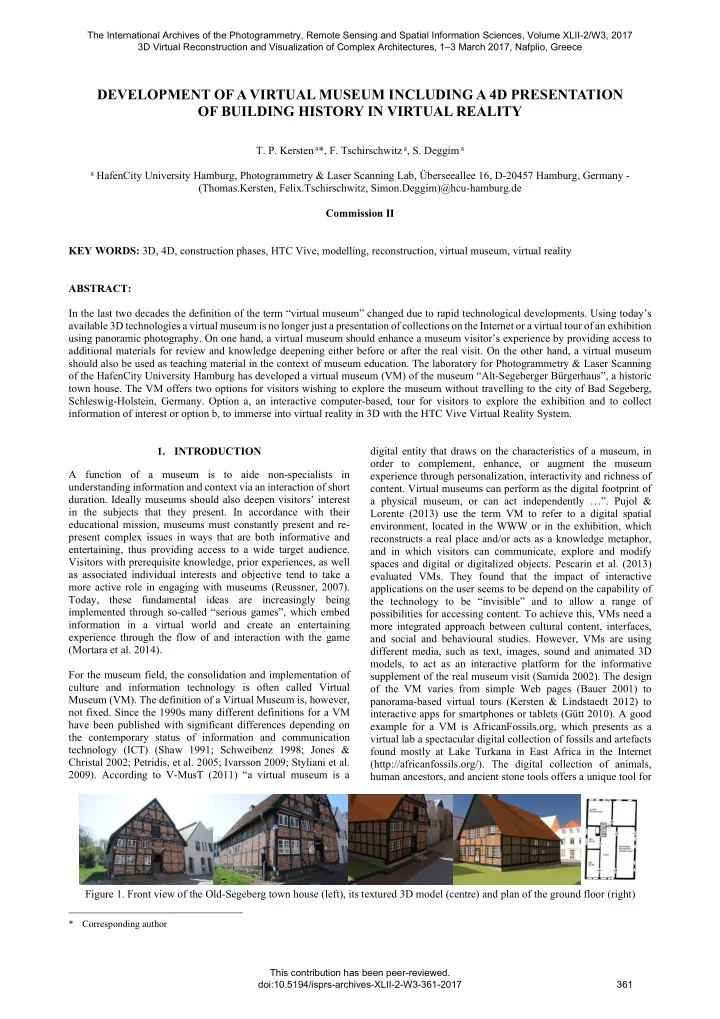

The International Archives of the Photogrammetry, Remote Sensing and Spatial Information Sciences, Volume XLII-2/W3, 2017 3D Virtual Reconstruction and Visualization of Complex Architectures, 1–3 March 2017, Nafplio, Greece DEVELOPMENT OF A VIRTUAL MUSEUM INCLUDING A 4D PRESENTATION OF BUILDING HISTORY IN VIRTUAL REALITY T. P. Kersten a *, F. Tschirschwitz a , S. Deggim a a HafenCity University Hamburg, Photogrammetry & Laser Scanning Lab, Überseeallee 16, D-20457 Hamburg, Germany - (Thomas.Kersten, Felix.Tschirschwitz, Simon.Deggim)@hcu-hamburg.de Commission II KEY WORDS: 3D, 4D, construction phases, HTC Vive, modelling, reconstruction, virtual museum, virtual reality ABSTRACT: In the last two decades the definition of the term “virtual museum” changed due to rapid technological developments. Using today’s available 3D technologies a virtual museum is no longer just a presentation of collections on the Internet or a virtual tour of an exhibition using panoramic photography. On one hand, a virtual museum should enhance a museum visitor’s experience by providing access to additional materials for review and knowledge deepening either before or after the real visit. On the other hand, a virtual museum should also be used as teaching material in the context of museum education. The laboratory for Photogrammetry & Laser Scanning of the HafenCity University Hamburg has developed a virtual museum (VM) of the museum “Alt-Segeberger Bürgerhaus”, a historic town house. The VM offers two options for visitors wishing to explore the museum without travelling to the city of Bad Segeberg, Schleswig-Holstein, Germany. Option a, an interactive computer-based, tour for visitors to explore the exhibition and to collect information of interest or option b, to immerse into virtual reality in 3D with the HTC Vive Virtual Reality System. 1. INTRODUCTION digital entity that draws on the characteristics of a museum, in order to complement, enhance, or augment the museum A function of a museum is to aide non-specialists in experience through personalization, interactivity and richness of understanding information and context via an interaction of short content. Virtual museums can perform as the digital footprint of duration. Ideally museums should also deepen visitors’ interest a physical museum, or can act independently …”. Pujol & in the subjects that they present. In accordance with their Lorente (2013) use the term VM to refer to a digital spatial educational mission, museums must constantly present and re- environment, located in the WWW or in the exhibition, which present complex issues in ways that are both informative and reconstructs a real place and/or acts as a knowledge metaphor, entertaining, thus providing access to a wide target audience. and in which visitors can communicate, explore and modify Visitors with prerequisite knowledge, prior experiences, as well spaces and digital or digitalized objects. Pescarin et al. (2013) as associated individual interests and objective tend to take a evaluated VMs. They found that the impact of interactive more active role in engaging with museums (Reussner, 2007). applications on the user seems to be depend on the capability of Today, these fundamental ideas are increasingly being the technology to be “invisible” and to allow a range of implemented through so-called “serious games”, which embed possibilities for accessing content. To achieve this, VMs need a information in a virtual world and create an entertaining more integrated approach between cultural content, interfaces, experience through the flow of and interaction with the game and social and behavioural studies. However, VMs are using (Mortara et al. 2014). different media, such as text, images, sound and animated 3D models, to act as an interactive platform for the informative For the museum field, the consolidation and implementation of supplement of the real museum visit (Samida 2002). The design culture and information technology is often called Virtual of the VM varies from simple Web pages (Bauer 2001) to Museum (VM). The definition of a Virtual Museum is, however, panorama-based virtual tours (Kersten & Lindstaedt 2012) to not fixed. Since the 1990s many different definitions for a VM interactive apps for smartphones or tablets (Gütt 2010). A good have been published with significant differences depending on example for a VM is AfricanFossils.org, which presents as a the contemporary status of information and communication virtual lab a spectacular digital collection of fossils and artefacts technology (ICT) (Shaw 1991; Schweibenz 1998; Jones & found mostly at Lake Turkana in East Africa in the Internet Christal 2002; Petridis, et al. 2005; Ivarsson 2009; Styliani et al. (http://africanfossils.org/). The digital collection of animals, 2009). According to V-MusT (2011) “a virtual museum is a human ancestors, and ancient stone tools offers a unique tool for Figure 1. Front view of the Old-Segeberg town house (left), its textured 3D model (centre) and plan of the ground floor (right) * Corresponding author This contribution has been peer-reviewed. doi:10.5194/isprs-archives-XLII-2-W3-361-2017 361
Recommend
More recommend